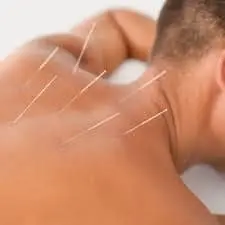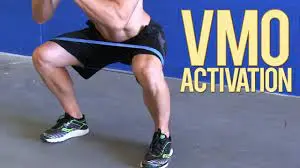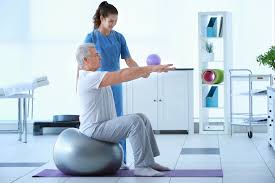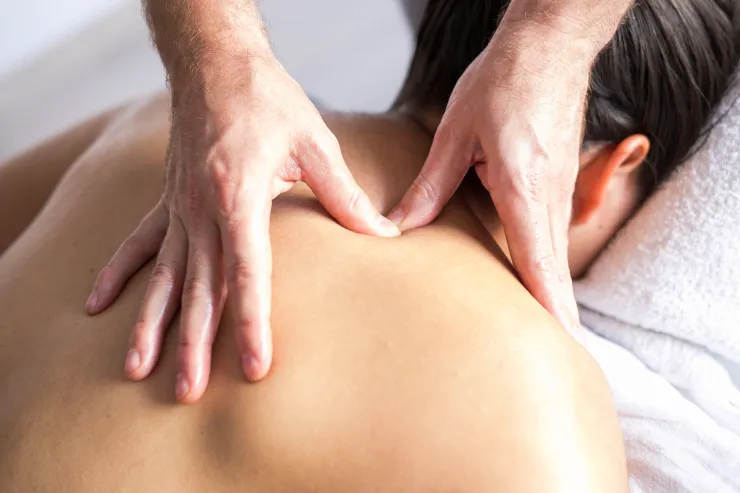Dry Needling
What is Dry Needling?
Dry needling is a therapeutic technique used by healthcare professionals, primarily physical therapists, to treat musculoskeletal pain and movement impairments. Unlike acupuncture, which is rooted in traditional Chinese medicine, dry needling is based on modern scientific principles of anatomy and neurophysiology.
During dry needling, thin needles are inserted into trigger points, or tight bands of muscle, to release tension and promote healing. The insertion of the needle can stimulate a twitch response in the muscle, which may help to relax it and reduce pain.
Acupuncturists, physical therapists, and other qualified medical professionals treat musculoskeletal pain and movement problems with dry needling. It’s nearly usually utilized in conjunction with other pain-reduction strategies, such as massage, stretching, exercise, and other methods. To address the underlying myofascial trigger points, the practitioner will puncture your skin with thin, sharp needles during this procedure.
“Myo” in “myofascial” refers to “muscle.” The thin, white connective tissue that envelops your muscles is called fascia.
Your muscles can develop tight, painful spots called trigger points. Touching these extremely sensitive trigger points might cause pain. A trigger point could occasionally be close to where you’re experiencing pain. However, they frequently trigger referred pain as well. Pain that radiates to another area of your body is known as referred pain.
Physical therapists can use needles to ease your trigger points. Applying dry needling to your muscles and tissues can improve blood flow, lessen referred and localized pain, and reduce tightness. The solid needles that healthcare providers use are free of any kind of medication. For this reason, the method is referred to be “dry.” Your body is not injected with anything. Injections at trigger points are unique. These are administered by physicians and include medicine.
MTrPs’ pathophysiology
The cause of trigger points is thought to be an excessive acetylcholine release from particular motor endplates. They are classified as either silent or active MTrPs. Active MTrPs can rapidly cause both local and transfer pain.
A taut band within the muscle develops to cause MTrPs. This band is brought on by the motor endplate producing an excessive amount of acetylcholine, together with acetylcholine esterase inhibition and nicotinic acetylcholine receptor upregulation.
Initially, taut bands develop as a physiological defense mechanism in reaction to existing or prospective muscle injury. It is thought that prolonged postures, recurrent low-load stress, and unusual eccentric or concentric loading cause these bands to form. But the longer they remain, the more misery they cause.
The pain associated with MTrPs is caused by hypoxia and decreased blood flow. Consequently, the pH decreases, inducing peripheral sensitivity and activating muscle nociceptors to regain equilibrium. In addition, MTrPs aid in educating the center. The precise method by which MTrPs support nociceptive input into the dorsal horn and facilitate central awareness remains a mystery.
Deep vs. superficial Dry Needling
The benefits of superficial dry needling include patient comfort, simplicity of administration, decreased risk of significant tissue trauma, and decreased risk of nerve and organ injury. The tissue beneath the skin is punctured by the needle up to a maximum of 10 mm.
To access MTrPs, deep dry needling entails inserting the needle into the muscle, past the subcutaneous tissue.
Mechanisms of Action
In individuals with musculoskeletal disorders, dry needling has been demonstrated to instantly improve ROM and pressure pain threshold, lower muscle tone, and lessen pain. Among the recommended modes of operation are:
- Local Twitch Response: When dry needling is applied to a twitchy area of the body, it can cause an involuntary spinal reaction that causes the targeted muscles to contract locally. Mechanoreceptors such as A-beta fibers can be stimulated and muscle fiber length and tension can change as a result of a local twitch response.
- Impact on Blood Flow: Local ischemia and hypoxia may result from a prolonged contraction of tense muscular bands in trigger sites. Vasodilation in the tiny blood vessels brought on by dry needling increases the oxygenation and blood flow to the muscles.
- Neurophysiological effects: Dry needling can cause both peripheral and central nervous system reactions, which can help to reduce both central and peripheral pain sensitization and promote homeostasis at the trigger point site.
- Remote Effects: It has been discovered that proximal MTrP can experience analgesia from dry needling of distal MTrP. There is contradictory data in the literature about the contralateral effect.
- Placebo Effect: Pain perception can be significantly influenced by expectations surrounding dry needling.
Indications
- Myofascial pain with the presence of trigger points
- Chronic pain
- Low back pain
- Strains
- Osteoarthritis
- Fibromyalgia
- Tendinopathies
Contraindications
Absolute contraindications
Patients in the following situations should not get dry needling (DN) therapy :
- unwilling or unable to consent because of age-related, fear-related, belief-related, communication-related, or cognitive issues.
- Acute medical ailment or medical emergency.
- localized illness
- over a limb or area that has lymphedema, as this could raise the chance of infection or cellulitis and make it more difficult to treat the illness, should it arise.
- Unsuitable for any additional purpose.
Relative Contraindications
- Abnormal bleeding tendency
- impaired immune system
- Vascular disease
- Diabetes
- Pregnancy
- Children
- weak patients
- Patients with epilepsy
- Psychological status
- Patient allergies
- Patient medication
- Unfit patient for whatever cause
Clinical Evidence
The therapist’s ability to precisely palpate myofascial trigger points and their kinaesthetic knowledge of the anatomical structures are critical components of this treatment’s efficacy.
A review of research found that there is moderate evidence that dry needling can lessen low back pain severity in patients, especially when used in conjunction with other therapies. It did note, however, that there is uncertainty regarding the long-term consequences of dry needling and its clinical superiority in reducing functional impairment.
A thorough review analysis of 16 studies—seven of which were RCTs—found that the use of DN alone or in conjunction with other therapies often improved stroke survivors’ range of motion (ROM), degree of spasticity, and degree of pain.
Another systematic review study found that among individuals with temporomandibular joint dysfunction, DN lessened the intensity of myofascial pain, which is typically connected to trigger points. It was also mentioned that trials with larger sample sizes and a lower risk of bias are required because there is a lack of information on this topic.
After a thorough analysis of 23 studies examining needling treatments for myofascial trigger point pain, it was shown that direct dry needling, which targets MTrPs directly, was just as effective as wet needling. Its superiority over placebo is not well demonstrated. To make certain findings on this, more high-quality research with genuine placebos and repeatable diagnostic criteria is required.
Level 1a evidence from a systematic review and meta-analysis led to the following conclusion:
In individuals with musculoskeletal pain, dry needling administered by a physical therapist offers very low to intermediate-quality evidence for superiority over no treatment or sham dry needling in terms of pain reduction and improved pressure pain threshold in the immediate to 12-week follow-up period.
Low-level evidence favors dry needling over sham dry needling and no treatment in terms of improving functional outcomes, but there is no difference when compared to other physical therapy treatments. The benefits of dry needling over the long term are not well supported by evidence.
Electric Dry Needling
Using two needles placed as electrodes to pass an electric current is known as electrical dry needling or EDN. An important benefit of utilizing EDN in acupuncture research or clinical practice is its ability to accurately and quantitatively set stimulation frequency and intensity.
Both low- and high-frequency electrostimulation are often utilized in clinical practice for a variety of illnesses. For muscle atrophy, in particular, low-frequency stimulation is advised, whereas high-frequency stimulation is advised for spinal spasticity.
In mice, EDN stimulation at 2 Hz appears to provide acupuncture analgesia through the binding of enkephalin, β-endorphin, and endomorphin to μ and δ opioid receptors. On the other hand, EDN stimulated at 100 Hz increases the release of dynorphin binding to the opioid receptor in the dorsal horn of the spinal cord, resulting in an analgesic effect similar to acupuncture.
The limbic system and limbic-related brain structures, such as the amygdala, hippocampus, hypothalamus, cingulate, prefrontal and insular cortices, basal ganglia, and cerebellum, were involved in the majority of studies that showed a broad neuro matrix response.
How does dry needling work?
Your muscle experiences an energy crisis when it is overworked, leading to insufficient blood flow to the muscle fibers. Your muscle can’t return to its typical resting state when it doesn’t receive the oxygen and nutrients it needs from a regular blood supply.
The tissue close to your trigger point gets more acidic when this occurs. It hurts because your nerves are irritated in that spot.
A needle can be used to stimulate a trigger point, which helps restore normal blood flow to the area and relieve stress. Additionally, the prick feeling may trigger nerve fibers in your brain that cause the production of endorphins, your body’s natural analgesic.
Your therapist will immediately pierce your skin to place a needle into a trigger point once they have identified it. To induce a brief muscular spasm known as a “local twitch response,” the physician may slightly adjust the needle.
This response may indicate that your muscle is contracting. Following a dry needling treatment, several people experience virtually instantaneous alleviation in their pain and mobility. Some people require multiple sessions.
Is dry needling painful?
To the touch, trigger sites are typically unpleasant. Therefore, you can feel some pain while your healthcare professional locates the trigger point before the needling.
During the needling, you might experience pain as well. Because the needle is so small, sometimes people don’t feel it piercing them, but other times they will. It can hurt and provoke a twitch reaction when the needle is in the trigger spot. Afterward, the area around the insertion site may feel tight or uncomfortable, but it’s crucial to maintain moving and stretching.
What does dry needling do?
You may be able to move more freely and get pain relief with dry needling. The following conditions can be managed by dry needling:
- Joint issues.
- Disk issues.
- Tendonitis.
- Migraine and tension-type headaches.
- Issues relating to the jaw and mouth, such as temporomandibular joint (TMJ) diseases.
- Bruising.
- Conditions involving repetitive motion, including carpal tunnel syndrome.
- Spinal issues.
- Pelvic pain.
- Night cramps.
- Phantom limb pain.
- Postherpetic neuralgia, a complication of shingles.
Who shouldn’t get dry needling treatments?
Dry needling should not be applied to people in specific groups. Providers advise against doing the procedure on children younger than twelve years old due to the potential for pain. Consent will be required from both you and your child, so you should think about less intrusive choices first. Individuals in the following categories should speak with their doctor before having dry needling:
- are carrying a child.
- are unable to fully understand the course of treatment.
- have a severe needle phobia (trypanophobia).
- have caused immune system compromises.
- recently undergone surgery.
- are taking anticoagulants.
Procedure Details
What happens before a dry needling treatment?
Before starting any dry needling treatment, your doctor will examine you and go over your medical history. They must decide whether dry needling is appropriate for you. If they determine that you are a candidate, they will address any concerns you may have and go over the details of the treatment.
On the day of your procedure, wear loose, comfortable attire. Wear anything that makes it simple for your healthcare professional to enter the treatment area. Your provider will offer you a gown or covering if not. A provider will lead you into a separate exam room or to a part of a bigger room that is closed off with curtains. They’ll position you correctly for your treatment and make any required adjustments to your outfit.
What happens during a dry needling treatment?
First, the medical practitioner will clean the treatment region and prepare the needle. Needles are always single-use, sterile, and made to be thrown away after use. The trigger point will then be found by feeling (palpating) the area with one hand or with fingers. They will cover the area with the needle, which is encircled by a plastic guide tube, using their other hand. Your provider can use one hand to correctly put the needle while using the guiding tube.
After carefully inserting the needle into the epidermis, your healthcare provider will remove the guide tube. The method your provider employs can change. Typical methods for dry needling include:
- Superficial: The needle will be inserted by your healthcare provider 5 to 10 millimeters into the subcutaneous tissue, which is the layer of skin directly above the trigger point.
- Deep: To reach the trigger point, your healthcare expert will pierce your muscle well below the surface layer.
Your healthcare professional may leave the needle in place for as little as two seconds or as long as twenty minutes, depending on the procedure used. They might also employ the pistoning method. This method, sometimes referred to as the in-and-out procedure, involves your healthcare provider quickly inserting and removing the needle into the tissue.
Only one or two needles may be used in your initial therapy by your physician. Your provider may begin to use more needles when they observe how you respond to the procedure. Depending on how you’re feeling. For example, during a back treatment, they might insert up to 10 or 15 needles along your spine.
You can experience muscle twitching or pain throughout the procedure. These feelings are typical and indicate how your muscles are reacting to the therapy.
What happens after a dry needling procedure?
Following the dry needling procedure, your healthcare professional will take out the needle and check your skin for any side effects. The medical sharps container will be used to dispose of the needle. You will then be asked to slowly stand up by your physician. They will ask you to take a seat and relax if you feel lightheaded before letting you leave the office.
To stay hydrated after your treatment, make sure to consume a lot of water. After the therapy, you might feel more sore in your muscles, but you should still move. This is typical and could persist for three to six days. Some bruises were visible close to the treated area. Up to a week may pass while this bruises.
Risks / Benefits
What are the benefits of dry needling?
There are numerous advantages to using dry needling in your entire treatment approach. The process is widely regarded as safe and is not pricey. If carried out by a qualified practitioner, the risk of problems is minimal.
According to research, dry needling can help reduce muscle pain and stiffness by releasing trigger points. Your range of motion and flexibility may also be enhanced by releasing your trigger points.
Dry Needling’s Four Benefits
By inserting a needle that resembles an acupuncture needle into the trigger point, one can relax the muscles, increase blood flow, reduce inflammation, and initiate a healing response. Additionally, this medication enhances neuronal transmission and triggers the release of endogenous analgesics.
Four advantages come from the actions that dry needling inspires:
Get Fast Pain Relief
Most people think that trigger points are related to tense muscles in their neck, upper back, and shoulders. However, the same issue can occur in any area of your body and be linked to a variety of ailments, such as joint pain, overuse injuries, and pain in the neck and lower back.
When the connective tissue loosens and blood flow increases, your pain lessens. Your muscles can absorb oxygen and nutrients for healing when your circulation is improved, and you can get out of waste items that are unpleasant and acidic.
After just one dry needling session, many patients report an instantaneous decrease in both localized and systemic pain. For some, the optimum pain relief may require several sessions. Your treatment plan will be based on the number and severity of trigger points.
Regain Your Range Of Motion
Few things prevent you from moving more than tense, sore muscles. You can have very restricted movement if you have several trigger points. Additionally, your muscles atrophy and lose mass while you are not moving.
To help you fully regain your range of motion and develop your muscles, we frequently combine dry needling with physical therapy. Retraining your muscles with physical therapy also helps to avoid trigger points in the future.
Speed Up Your Rehabilitation
Whether you had surgery or were injured, the greatest way to accelerate your recovery and encourage healing is to move your body. Physical therapy is the primary form of treatment during your recovery. However, when dry needling is used along with physical therapy, the process proceeds faster.
Improve Chronic Pain Condition
The two chronic pain conditions that dry needling greatly help are myofascial pain syndrome and fibromyalgia.
The development of trigger points in the fascia—a sheet of connective tissue that envelops and supports all of your muscles, nerves, blood vessels, and organs—causes myofascial pain syndrome. Physical therapy and dry needling are two of the most effective treatments for this chronic pain syndrome.
Your muscles will hurt all over and become tender if you have fibromyalgia. Your gait is impacted by the pain, which eventually results in trigger points. When receiving dry needling for fibromyalgia, patients frequently report a marked reduction in their overall pain.
What possible negative effects can dry needling cause?
Soreness both during and after treatment is the most frequent adverse effect of dry needling.
Most other adverse effects are not very serious. They could consist of:
- Stiffness.
- Bruising at or near the insertion site.
- Losing consciousness.
- Fatigue.
Adverse effects are quite uncommon. On the other hand, if you start to notice bleeding from the insertion site, call your doctor or provider and apply pressure. If you experience dyspnea, get in touch with your doctor or provider right away, or dial 911. A collapsed lung (pneumothorax) could result in needling in your thoracic region.
Although incredibly uncommon, this calls for additional attention and a chest X-ray.
Additional Details
Dry needling vs. acupuncture — what’s the difference?
Dry needling and acupuncture are not the same. Needles are inserted into your skin throughout both operations. They employ identical types of needles, which is the only similarity between them.
Dry needling is done by several professionals with varying levels of training. Whereas dry needling is based in Western medicine and involves assessment of pain patterns, postures, improper movement patterns, and orthopedic testing, acupuncture is administered by qualified acupuncturists and is rooted in Eastern medicine.
In addition to treating musculoskeletal pain, acupuncture also helps other bodily systems. The purpose of dry needling is to treat muscle tissue to improve movement, reduce pain, and deactivate trigger points. It is usually utilized in conjunction with other physical therapy treatments as part of a more comprehensive physical therapy approach.
Is dry needling available in every state?
No, 37 states as well as Washington, D.C. have authorized the use of dry needling physical therapy. Certain states prohibit dry needling because of legislation governing providers in certain states. Licensed physical therapists, athletic trainers, chiropractors, or medical professionals with training in the technique execute dry needling, depending on the state.
Conclusion
For the temporary alleviation of pain in a variety of musculoskeletal disorders, dry needling exhibits potential. More study is necessary because there is insufficient evidence for long-term benefits.
FAQ
Why is dry needling illegal in India?
As of right now, dry needling is not specifically governed by any law in India. Because of this, some medical practitioners have begun instructing other therapists without first participating in an instructor training program.
What are the risks of dry needling?
Patients may be at risk for iatrogenic harm to arteries, nerves, spinal cord, internal organs, implanted devices, or infection because dry needling entails a needle puncturing the skin.
Is dry needling the same as acupuncture?
One last differentiation is based on penetration points. To alleviate tension and promote healing, dry needling punctures the skin at particular trigger sites. Acupuncture aims to restore balance and appropriate energy flow to the patient’s body by targeting points along meridian lines that correspond to bodily organs.
How long does dry needling last?
Although muscle tension and soreness are typically relieved immediately with dry needling, patients typically see the greatest improvement 48 hours following treatment. These effects usually subside after a week or so, but three treatments at the very least are necessary to achieve longer-term advantages.
Is dry needling expensive?
To find out if and how much dry needling is covered by their plan, patients can contact their insurance company. Patients who do not have insurance coverage for dry needling should typically budget between $50 and $150 per session.
What is the cost of dry needling in India?
The price of the procedure varies depending on the location. However, the cost of a single dry-needling session might range from Rs. 500 to Rs. 1,000.
Is dry needling useless?
The effectiveness of dry needling is still unknown at best, but it’s more likely that it won’t work at all.
Is dry needling permanent?
Dry needling usually leaves its effects a few days after the first session. Clients should anticipate longer-lasting results with each subsequent session, nevertheless, due to continued muscular relaxation and restoration to normal muscle function.
Can dry needling damage nerves?
Myofascial trigger points are the site of repeated, fast needle insertions in certain dry-needling procedures. This kind of treatment damages nerve fibers and injures muscles.
Can dry needling damage muscles?
In conclusion, dry needling is a method that, regardless of muscle tone, results in moderate damage.
References
- Professional, C. C. M. (n.d.). Dry Needling. Cleveland Clinic. https://my.clevelandclinic.org/health/treatments/16542-dry-needling
- Dry Needling. (n.d.). Physiopedia. https://www.physio-pedia.com/Dry_Needling
- J. (2022, May 9). 4 Health Benefits of Dry Needling | Prolete Physical Therapy & Sports Medicine. Prolete Physical Therapy & Sports Medicine. https://proletept.com/4-health-benefits-of-dry-needling/








3 Comments